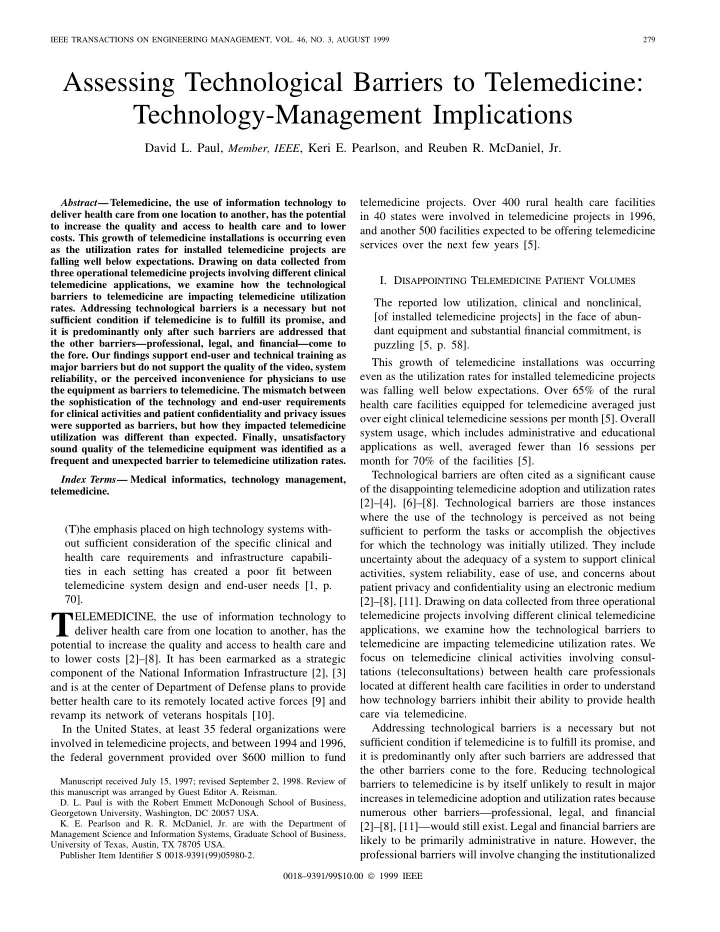

IEEE TRANSACTIONS ON ENGINEERING MANAGEMENT, VOL. 46, NO. 3, AUGUST 1999 279 Assessing Technological Barriers to Telemedicine: Technology-Management Implications David L. Paul, Member, IEEE , Keri E. Pearlson, and Reuben R. McDaniel, Jr. telemedicine projects. Over 400 rural health care facilities Abstract— Telemedicine, the use of information technology to deliver health care from one location to another, has the potential in 40 states were involved in telemedicine projects in 1996, to increase the quality and access to health care and to lower and another 500 facilities expected to be offering telemedicine costs. This growth of telemedicine installations is occurring even services over the next few years [5]. as the utilization rates for installed telemedicine projects are falling well below expectations. Drawing on data collected from three operational telemedicine projects involving different clinical I. D ISAPPOINTING T ELEMEDICINE P ATIENT V OLUMES telemedicine applications, we examine how the technological barriers to telemedicine are impacting telemedicine utilization The reported low utilization, clinical and nonclinical, rates. Addressing technological barriers is a necessary but not [of installed telemedicine projects] in the face of abun- sufficient condition if telemedicine is to fulfill its promise, and dant equipment and substantial financial commitment, is it is predominantly only after such barriers are addressed that the other barriers—professional, legal, and financial—come to puzzling [5, p. 58]. the fore. Our findings support end-user and technical training as This growth of telemedicine installations was occurring major barriers but do not support the quality of the video, system even as the utilization rates for installed telemedicine projects reliability, or the perceived inconvenience for physicians to use was falling well below expectations. Over 65% of the rural the equipment as barriers to telemedicine. The mismatch between the sophistication of the technology and end-user requirements health care facilities equipped for telemedicine averaged just for clinical activities and patient confidentiality and privacy issues over eight clinical telemedicine sessions per month [5]. Overall were supported as barriers, but how they impacted telemedicine system usage, which includes administrative and educational utilization was different than expected. Finally, unsatisfactory applications as well, averaged fewer than 16 sessions per sound quality of the telemedicine equipment was identified as a month for 70% of the facilities [5]. frequent and unexpected barrier to telemedicine utilization rates. Technological barriers are often cited as a significant cause Index Terms— Medical informatics, technology management, of the disappointing telemedicine adoption and utilization rates telemedicine. [2]–[4], [6]–[8]. Technological barriers are those instances where the use of the technology is perceived as not being (T)he emphasis placed on high technology systems with- sufficient to perform the tasks or accomplish the objectives out sufficient consideration of the specific clinical and for which the technology was initially utilized. They include health care requirements and infrastructure capabili- uncertainty about the adequacy of a system to support clinical ties in each setting has created a poor fit between activities, system reliability, ease of use, and concerns about telemedicine system design and end-user needs [1, p. patient privacy and confidentiality using an electronic medium 70]. [2]–[8], [11]. Drawing on data collected from three operational telemedicine projects involving different clinical telemedicine T ELEMEDICINE, the use of information technology to applications, we examine how the technological barriers to deliver health care from one location to another, has the telemedicine are impacting telemedicine utilization rates. We potential to increase the quality and access to health care and focus on telemedicine clinical activities involving consul- to lower costs [2]–[8]. It has been earmarked as a strategic tations (teleconsultations) between health care professionals component of the National Information Infrastructure [2], [3] located at different health care facilities in order to understand and is at the center of Department of Defense plans to provide how technology barriers inhibit their ability to provide health better health care to its remotely located active forces [9] and care via telemedicine. revamp its network of veterans hospitals [10]. Addressing technological barriers is a necessary but not In the United States, at least 35 federal organizations were sufficient condition if telemedicine is to fulfill its promise, and involved in telemedicine projects, and between 1994 and 1996, it is predominantly only after such barriers are addressed that the federal government provided over $600 million to fund the other barriers come to the fore. Reducing technological Manuscript received July 15, 1997; revised September 2, 1998. Review of barriers to telemedicine is by itself unlikely to result in major this manuscript was arranged by Guest Editor A. Reisman. increases in telemedicine adoption and utilization rates because D. L. Paul is with the Robert Emmett McDonough School of Business, numerous other barriers—professional, legal, and financial Georgetown University, Washington, DC 20057 USA. K. E. Pearlson and R. R. McDaniel, Jr. are with the Department of [2]–[8], [11]—would still exist. Legal and financial barriers are Management Science and Information Systems, Graduate School of Business, likely to be primarily administrative in nature. However, the University of Texas, Austin, TX 78705 USA. professional barriers will involve changing the institutionalized Publisher Item Identifier S 0018-9391(99)05980-2. 0018–9391/99$10.00 1999 IEEE
Recommend
More recommend